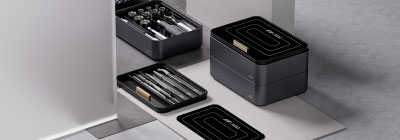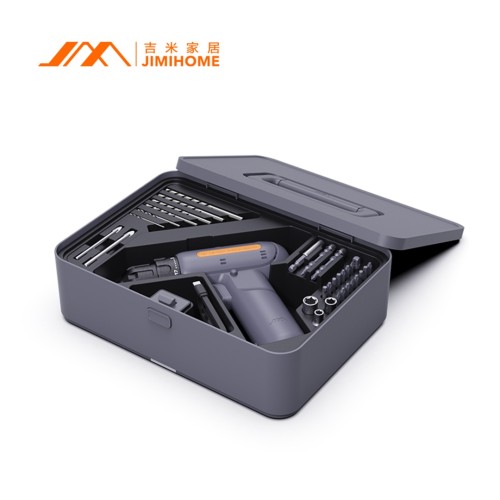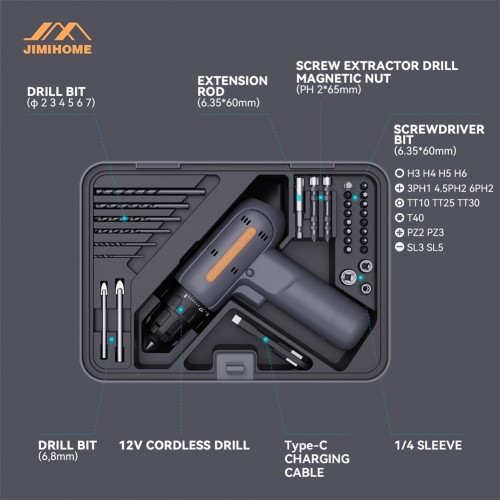
How Beginners Can Safely Use a 12V Electric Drill
A practical, safety-first guide for new users
Introduction
A 12V cordless drill is an excellent tool for household repairs, furniture assembly, and light-to-medium DIY projects. Compared to larger drills, 12V models are lighter and easier to control, making them ideal for beginners. However, safe and effective operation requires understanding proper technique, drill parts, and maintenance. This guide walks beginners through preparation, safe usage, drill bit selection, battery care, and common mistakes.
1. Read the Manual First
Always read the manufacturer’s user manual before using any power tool. Manuals provide essential information about safety features (trigger lock, clutch settings, hammer mode), rated voltage, and battery/charger compatibility. Following the manual reduces misuse and risk of accidents.
2. Know the Basic Components
-
Battery & Charger – ensure correct charger and voltage match.
-
Trigger & Speed Control – most 12V drills offer variable speed via trigger pressure.
-
Forward/Reverse Switch – for driving or removing screws, and releasing stuck bits.
-
Torque/Clutch Ring – prevents over-driving screws; start low and increase as needed.
-
Chuck – keyless chucks twist open/close to hold the drill bit securely.
Familiarity with these parts makes operation predictable and safer.
3. Personal Protective Equipment (PPE)
Always wear:
-
Safety glasses to protect from flying debris.
-
Appropriate gloves when handling rough materials (avoid bulky gloves that reduce dexterity).
-
Tie back long hair, secure loose clothing, and remove jewelry to prevent entanglement.
4. Choosing and Installing the Correct Drill Bit
-
Match the bit type to the material: HSS or cobalt for metal, spade or brad-point bits for wood, masonry bits for concrete or brick. Coatings (TiN, black oxide) and bit material affect durability and heat tolerance.
-
Drill a pilot hole when using screws to prevent splitting and ensure accurate positioning. Refer to a pilot hole chart if unsure.
-
Insert the bit fully into the chuck, hand-tighten, then lightly squeeze the trigger once to seat the bit, and re-check tightness.
5. Proper Grip and Stance
Stand with feet shoulder-width apart. Hold the drill with both hands (one on the handle, one supporting the back or side of the drill). Keep the drill perpendicular to the work surface unless intentionally angling. Stable body position prevents the drill from slipping if the bit grabs.
6. Start Drilling Slowly
Begin at low speed to establish a pilot hole, then gradually increase speed. Apply steady, moderate pressure. Avoid forcing the drill or applying lateral pressure, which can break the bit or cause slippage. Use the clutch when driving screws to prevent stripping.
7. Battery Charging and Li-ion Safety
-
Use the manufacturer-provided charger; never use mismatched chargers.
-
Charge in a cool, dry location, away from flammable materials.
-
Disconnect chargers after full charge. Damaged or swollen batteries should be taken to authorized recycling or service centers. Proper battery care reduces fire risk and prolongs battery life.
8. Common Mistakes and How to Avoid Them
-
Using the wrong bit for the material → match bit type to material.
-
Not drilling a pilot hole for large screws → refer to a pilot hole chart.
-
Over-torquing screws → use the clutch and stop when flush.
-
Ignoring battery care → avoid frequent full discharges and exposure to high temperatures; partial charging is better for Li-ion life.
9. Maintenance Checklist
-
Keep vents and chuck free of dust/debris.
-
Inspect bits for wear; replace if dull, bent, or chipped.
-
Clean battery contacts.
-
Store the drill and batteries in a cool, dry place.
-
If the drill vibrates unusually or produces smoke/odors, stop using it and have it serviced. Proper maintenance extends tool life and reduces failure risks.
10. Disposal and Transport of Batteries and Damaged Tools
Do not throw Li-ion batteries in household trash. Follow manufacturer and local regulations for battery recycling. Damaged batteries (swollen, leaking) should be treated as hazardous waste — placed in non-conductive, fire-resistant containers and taken to authorized recyclers.
Quick Reference Checklist
-
Read the manual and verify battery/charger compatibility.
-
Wear safety glasses and secure loose clothing.
-
Select the correct drill bit and tighten the chuck.
-
Clamp the workpiece; start slow; drill a pilot hole if necessary.
-
Use clutch for screw driving; reverse to release stuck bits.
-
Charge and store batteries properly; recycle old batteries safely.
Conclusion
A 12V drill is lightweight, versatile, and beginner-friendly when used properly. Follow manufacturer guidance, wear basic protective gear, choose the right drill bits, and maintain the tool regularly. These habits will help you gain confidence and complete DIY projects safely.
SEO / Meta
-
Meta Title: How Beginners Can Safely Use a 12V Electric Drill — Step-by-Step Guide
-
Meta Description: Practical, safety-first guide for beginners using 12V cordless drills: parts, bit selection, pilot holes, torque control, battery care, and maintenance.
-
Meta Keywords: 12V drill beginner, cordless drill safety, drill bit guide, pilot hole sizing, lithium battery care
-
SEO URL Keyword: beginner-12v-drill-guide






Leave a Comment